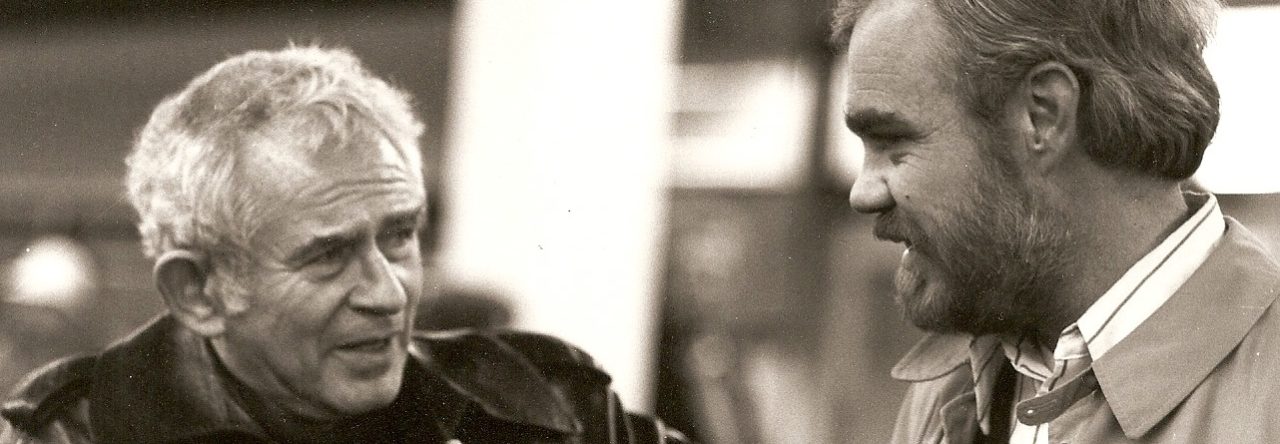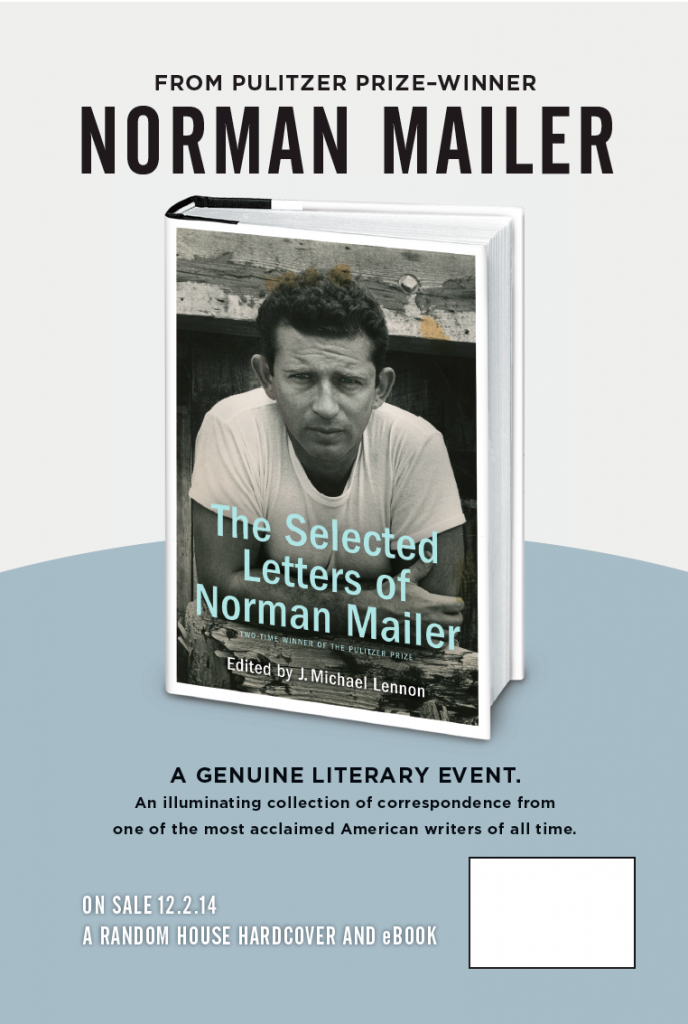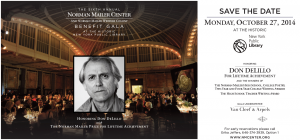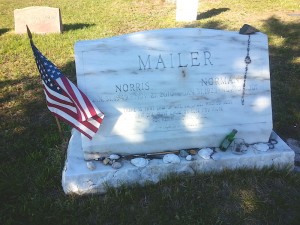Mike Lennon remembers when he and Norman Mailer became acquainted. “I saw him on the Dick Cavett show, the famous show when he was on with Gore Vidal and Janet Flanner, and they got into an imbroglio over various issues,” Lennon said. “I wrote him a letter and told him that I thought Vidal had maligned him unfairly. Lo and behold, I got a wonderful long letter back from him.” Then a graduate student at the University of Illinois, Lennon says he was “quite shocked and moved” that the famous author would write him back.
Author J. Michael Lennon will visit the Provincetown Public Library on Friday, August 15 at the invitation of the Board of Library Trustees, to present his New York Times Editor’s Choice book, Norman Mailer: A Double Life, at 5pm in the Marc Jacobs Reading Room. As the current president of the Norman Mailer Society, Lennon will also speak about the future of the organization. Susan Mailer, daughter of the late author, will introduce Mike Lennon at the event.
After meeting Mailer in 1972, Michael Lennon edited several high-profile works on the author, including Critical Essays on Norman Mailer (1986), Conversations with Norman Mailer (1988), The James Jones Reader (1991), and Norman Mailer’s Letters on An American Dream, 1963-69 (2004). Lennon will also provide insight into Mailer’s legacy in Provincetown as part of his presentation.
Attendees are asked to provide a minimum admission donation of $15 at the door. Refreshments and hors d’oeuvres will be provided by Cosmos Catering, a local Provincetown business. Copies of Norman Mailer: A Double Life, will be available for purchase at the Library beginning July 15, and will also be on sale at the event on the evening of August 15.
The personification of cool, however, continued to be the hipster. Norman Mailer, a close reader of Anatole Broyard, was clearly influenced by Broyard’s essays on the subject, but made the connection to black culture even more explicit in “The White Negro.”
Bogging down in J. Michael Lennon’s biography of Norman Mailer, A Double Life, just about the point where I’d have expected. The Naked and the Dead is a bestseller and Mailer’s trying to cope with his newly acquired celebrity—mostly by sleeping with as many women as he can find time to—hanging out in Hollywood, looking to sell the screen rights and struggling to come up with an idea for his next novel.
Which puts him in the same position he’ll be in for the rest of his life. A celebrity writer whose fame and reputation rest on his being a great novelist but who has no more great novels in him to write.
Lennon captures Mailer’s enormous drive to master his craft, to experiment with form and genre, to build a reputation, and to contend with the large issues of his country and culture for six decades. This biography is not only indispensable for students of Mailer, but also for anyone interested in taking the pulse of the United States through those decades. More and more, Mailer put himself on the stages of literary and political history, shaping both through his participation and shaping our collective memory through his influential, if sometimes abrasive, representations.
This is a quick note to alert those who may be in the environs of two upcoming readings from Norman Mailer: A Double Life. The first event will be at The Mount, former home of Edith Wharton, in Stockbridge, Massachusetts, on August 4, 4-6 p.m. The reading is sold out, but there is a telecast in adjoining room. Also, I am told there is a waiting list because of possible cancellations.
On August 15, at 5 p.m., I will be at the Provincetown Public Library. Susan Mailer will introduce me (thanks Sue!).
The Selected Letters of Norman Mailer has a firm publication date of December 2. Review copies can be obtained from Caitlin McKenna of Random House.
The edition runs to 860 pages and contains 714 of Mailer letters to about 350 different people, including many of the leading writers of Mailer’s era: Henry Miller, Mary McCarthy, Truman Capote, Lillian Hellman, Lillian Ross, Robert Lowell, William Styron, John Irving, Alfred Kazin, James Jones, James Baldwin, Dwight Macdonald, Arthur Miller, Allen Ginsberg, Saul Bellow, Jimmy Breslin, Don DeLillo, Joyce Carol Oates and Philip Roth. Here is the flap copy:
Over the course of a nearly seventy-year career, Norman Mailer wrote more than thirty novels, essay collections, and nonfiction books. Yet nowhere was he more prolific—or more exposed—than in his letters. All told, Mailer crafted more than forty-five thousand pieces (approximately 25 million words) of deeply personal correspondence, keeping a copy of almost every one. Now, the best of these are published—most for the very first time—in one stunning volume that spans five decades and, it seems, several lifetimes.
Compiled by Mailer’s authorized biographer J. Michael Lennon and organized by decade, The Selected Letters of Norman Mailer features the most fascinating of Mailer’s missives from 1939 to 2007—letters to his family and friends; fans and fellow writers (including Truman Capote, James Baldwin, and Phillip Roth); political figures from Henry Kissinger to Bill and Hillary Clinton; and such cultural icons as John Lennon, Marlon Brando, and even Monica Lewinsky. Together they form a stunning autobiographical portrait of one of the most original, provocative, and outspoken public intellectuals of the twentieth century.
Here is Mailer the precocious Harvard undergraduate, writing home to his parents for the first time and worrying that his acceptances by literary magazines were “all happening too easy.” Here, too, is Mailer the soldier, confronting the violence of war in the Pacific that would become the subject of his masterly debut novel The Naked and the Dead: “[I’m] amazed how casually it fits into . . . daily life, how very unhorrible it is.” Mailer the international celebrity grapples with the vicissitudes of newfound fame (“Life is really rather extravagant [now],” while the ‘80s Mailer agonizes over the fallout from his ill-fated friendship with Jack Henry Abbott, the murderer who became his literary protégé. (“The continuation of our relationship was depressing for both of us,” he confesses to Joyce Carol Oates). At last, he finds domestic—and erotic—bliss in the arms of his sixth wife, Norris Church (“We bounce into each other like sunlight”).
Whether he is opining about the Kennedy assassination, assessing the merits of authors from Fitzgerald to Proust, or threatening to pummel William Styron, the brilliant, pugnacious Norman Mailer comes alive again in these letters. The myriad lives of this lover and fighter, artist and activist, public figure and private man are laid bare in this collection as never before.
You can order a copy of The Selected Letters of Norman Mailer from Amazon.
In September, Taschen Books will publish a new edition of “Superman Comes to the Supermarket,” lavishly illustrated, with my introduction. And on October 28, the paperback of my biography will be published by Simon & Schuster.
I hope everyone is having a terrific summer, and that our paths cross soon.
Cheers, Mike
p.s. There are many new posts on my website; please take a look. It also has information on the upcoming Mailer Society meeting (October 8-11) at Wilkes University, and the Mailer Center Gala, October 27, at the New York Public Library.
The Mailer grave on Memorial Day, by Stephen Borkowski. He writes:
Memento Mori
A long standing tradition in Provincetown is to place a flag on the graves of Veterans for Memorial Day.The large marker commemorating the fallen during the Civil War features the most prominent display with the square plot circled with flags about nine inches apart.
I volunteered to do a portion of the cemetery historically known as the “Protestant Section” to distinguish it from the largely Portuguese Catholic section across the road.There are the graves of many artists of many denominations. The grave of Norman Mailer is among them, with his wife Norris Church Mailer interred by his side. The still gleaming white marble festooned with mementos unintentionally stands out among the stark terrain.
I felt a certain pride as my gloved hands pushed the stake end about 6 inches into the soft earth to acknowledge his service during wartime. Broadly, their contributions to my life and to the local cultural landscape, over many decades, will not be easily forgotten.



